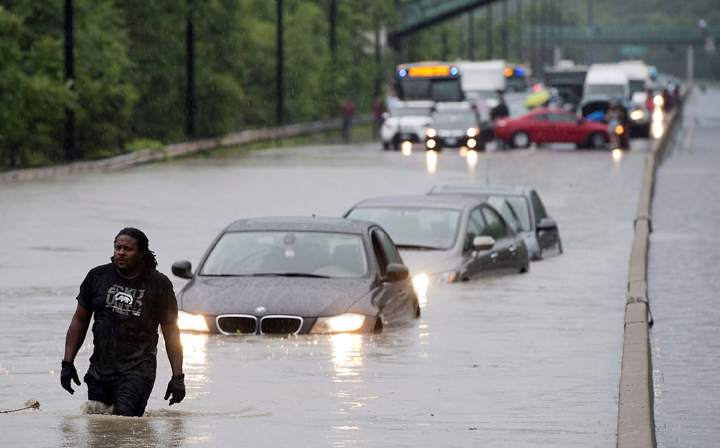The Earth is warming up, and in the process creating the perfect conditions for heavy precipitation and other severe weather, said Canada’s top climatologist.

Heavy downpours have become more frequent in the United States, a new report states, and increased precipitation is projected in the future. Canada should expect much of the same, said Environment Canada’s senior climatologist David Phillips.
READ MORE: Earth on track to heat up to devastating levels by 2100, scientists say
“This is one of the fallouts of a warmer world, and one that will be more troublesome than not, because of the fact that we’re not equipped to handle the heavier dose of rain,” said Phillips.
“It’s something we’ve known for centuries: Every time the world gets warmer, the atmosphere holds more moisture. A one-degree warming allows the atmosphere to hold, say, 12 per cent more precipitation — more rainfall or snow.”

That opens the door to heavier, more robust rain or snowfalls.
The Earth has warmed up by nearly a degree in the last 135 years, Phillips said, while parts of Canada have warmed up by 2 to 3 C in half that time.
- B.C. introduces legislation recognizing Haida Gwaii Indigenous title
- Whale experts confident B.C. orca calf will survive, find family if rescue plan succeeds
- Chemical plant shuts down after high benzene levels detected near Ontario First Nation
- Ontario takes action against chemical plant after Aamjiwnaang First Nation residents fell ill
READ MORE: 2016 will be the hottest year on record
Large continental areas, such as Canada, warm up more than the global average, Edward A. Parson, faculty co-director at UCLA’s Emmett Center on Climate Change and the Environment, told Global News in a recent interview.
“It’s a rough rule of thumb, a mid-to-high latitude, big continental area like Canada, it warms one-and-a-half to two times as much as the global average,” Parson said.

Such warming leads to more severe weather in all its forms.
One area can see drought conditions, while there will be floods in others. Or, it can flip-flop between the two. Tropical storms will strengthen and the number of tornadoes could increase. The impacts could be felt across the board.
“It’s likely to be a big, big mess.”
READ MORE: Top 10 most costly disasters in Canadian history for insurers
In Canada, “there is evidence” we’re already seeing the results, Phillips said.
In July 2013, Toronto was hit by an intense storm that dropped between 97 and 125 mm of rain in two hours. The storm flooded streets, forcing some motorists to abandon their vehicles, and nearly 1,400 commuters had to be rescued from a GO Train. The storm caused nearly $1 billion in insurance damage.
In July, Fort McMurray, Alta., was hit by 88 mm of rain in the span of two hours, just months after it was devastated by wildfire.
WATCH: ‘It’s a lot to deal with’: Fort McMurray residents clean up after rainfall, flooding

In September, Windsor, Ont., was hit by a three-day storm that caused $100 million in insurance damage.
“When it rains, it gives you a belly washer as opposed to just a nice gentle slow motion rain,” said Phillips.
The climate has changed, the experts agree, and Canadians need to adapt.
For one thing, our infrastructure changes the Earth’s ability to absorb a deluge from heavy precipitation. More concrete, asphalt and buildings rather than grass and fields, creates the perfect environment for flooding.
Greener infrastructure and beefed up drainage systems need to be designed, Phillips said.
And of course, Canadians need to contribute to efforts to slow climate change; you can read more about reducing your carbon footprint here.




Comments